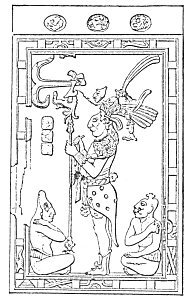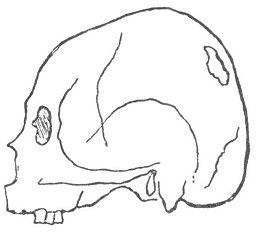
Atlantis, the Antediluvian World, by Ignatius Donnelly, [1882], at sacred-texts.com

Atlantis, the Antediluvian World, by Ignatius Donnelly, [1882], at sacred-texts.com
AN examination of the American monuments shows (see figure on page 269) that the people represented were in the habit of flattening the skull by artificial means. The Greek and Roman writers had mentioned this practice, but it was long totally forgotten by the civilized world, until it was discovered, as an unheard-of wonder, to be the usage among the Carib Islanders, and several Indian tribes in North America. It was afterward found that the ancient Peruvians and Mexicans practised this art: several flattened Peruvian skulls are depicted in Morton's "Crania Americana." It is still in use among the Flat-head Indians of the north-western part of the United States.
In 1849 a remarkable memoir appeared from the pen of M. Rathke, showing that similar skulls had been found near Kertsch, in the Crimea, and calling attention to the book of Hippocrates, "De Aeris, Aquis et Locu," lib. iv., and a passage of Strabo, which speaks of the practice among the Scythians. In 1854 Dr. Fitzinger published a learned memoir on the skulls of the Avars, a branch of the Uralian race of Turks. He shows that the practice of flattening the head had existed from an early date throughout the East, and described an ancient skull, greatly distorted by artificial means, which had lately been found in Lower Austria. Skulls similarly flattened have been found in Switzerland and Savoy. The Huns under Attila had the same practice of flattening the heads. Professor Anders Retzius proved (see "Smithsonian Report," 1859) that the custom still exists in the south of France, and in parts of Turkey.
[paragraph continues] "Not long since a French physician surprised the world by the fact that nurses in Normandy were still giving the children's heads a sugar-loaf shape by bandages and a tight cap,

STUCCO BAS-RELIEF IN THE PALACE OF PALENQUE.
while in Brittany they preferred to press it round. No doubt they are doing so to this day." (Tylor's "Anthropology," p. 241.)
Professor Wilson remarks:
"Trifling as it may appear, it is not without interest to have the fact brought under our notice, by the disclosures of ancient
barrows and cysts, that the same practice of nursing the child and carrying it about, bound to a flat cradle-board, prevailed in Britain and the north of Europe long before the first notices of written history reveal the presence of man beyond the Baltic or the English Channel, and that in all probability the same custom prevailed continuously from the shores of the German Ocean to Behring's Strait." ("Smithsonian Report," 1862, p. 286.)
Dr. L. A. Gosse testifies to the prevalence of the same custom among the Caledonians and Scandinavians in the earliest times; and Dr. Thurman has treated of the same peculiarity among the Anglo-Saxons. Crania Britannica," chap. iv., p. 38.)
 ANCIENT SWISS SKULL. |
The annexed out represents an ancient Swiss skull, from a cemetery near Lausanne, from a drawing of Frederick Troyon. Compare this with the illustration given on page 271, which represents a Peruvian flat-head, copied from Morton's "Ethnography and Archæology of the American Aborigines," 1846. This skull is shockingly distorted. The dotted lines indicate the course of the bandages by which the skull was deformed.

CHINOOK (FLAT-HEAD), AFTER CATLIN.
The following heads are from Del Rio's "Account of Palenque," copied into Nott and Gliddon's "Types of Mankind," p. 440. They show that the receding forehead was a natural characteristic of the ancient people of Central America. The same form of head has been found even in fossil skulls. We may therefore conclude that the skull-flattening, which we find to have been practised in both the Old and New Worlds, was
an attempt of other races to imitate the form of skull of a people whose likenesses are found on the monuments of Egypt and of America. It has been shown that this peculiar form of the head was present even in the fœtus of the Peruvian mummies.
Hippocrates tells us that the practice among the Scythians was for the purpose of giving a certain aristocratic distinction.
Amedée Thierry, in his "History of Attila," says the Huns used it for the same reason; and the same purpose influences the Indians of Oregon.
Dr. Lund, a Swedish naturalist, found in the bone caves of Minas-Geraes, Brazil, ancient human bones associated with the remains of extinct quadrupeds. "These skulls," says Lund, "show not only the peculiarity of the American race but in an excessive degree, even to the entire disappearance of the forehead." Sir Robert Schomburgh found on some of the affluents of the Orinoco a tribe known as Frog Indians, whose heads were flattened by Nature, as shown in newly-born children.
In the accompanying plate we show the difference in the conformation of the forehead
 OUTLINES OF SKULLS OF DIFFERENT RACES. |
Not only do we find the same receding forehead in the skulls of the ancient races of Europe and America, and the same attempt to imitate this natural and peculiar conformation by artificial flattening of the head, but it has been found (see Henry Gillman's "Ancient Man in Michigan," "Smithsonian Report," 1875, p. 242) that the Mound Builders and Peruvians of America, and the Neolithic people of France and the Canary Islands, had alike an extraordinary custom of boring a circular bole in the top of the skulls of their dead, so that the soul might readily pass in and out. More than this, it has been found that in all these ancient populations the skeletons exhibit a remarkable degree of platicnemism, or flattening of the tibiæ or leg bones. (lbid., 1873, p.367.) In this respect the Mound Builders of Michigan were identical with the man of Cro Magnon and the ancient inhabitants of Wales.
The annexed ancient Egyptian heads, copied from the monuments, indicate either that the people of the Nile deformed their heads by pressure upon the front of the skull, or that
there was some race characteristic which gave this appearance to their heads. These heads are all the heads of priests, and therefore represented the aristocratic class.
The first illustration below is taken from a stucco relief
 CENTRAL AMERICAN HEAD. |
 EGYPTIAN HEAD. |
The outline drawing on the following page shows the form of the skull
of the royal Inca line: the receding forehead here seems to be natural, and not the result of artificial compression.
Both illustrations at the bottom of the preceding page show the same receding form of the forehead, due to either artificial deformation of the skull or
 PERUVIAN INCA SKULL, FROM THE ANCIENT CEMETARY OF PAHACAMAC. |
We must add the fact that the extraordinary practice of deforming the skull was found all over Europe and America to the catalogue of other proofs that the people of both continents were originally united in blood and race. With the couvade, the practice of circumcision, unity of religious beliefs and customs, folk-lore, and alphabetical signs, language and flood legends, we array together a mass of unanswerable proofs of prehistoric identity of race.